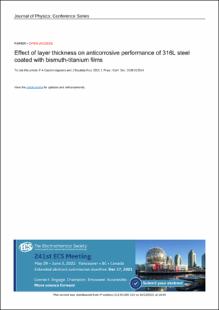Effect of layer thickness on anticorrosive performance of 316L steel coated with bismuth-titanium films
Documento de Conferencia
2021-05
Journal of Physics: Conference Series
. Bismuth and titanium are elements with remarkable properties and applications in
technological developments and in the field of biomedical engineering. The sol-gel method
was used to form a bismuth-titanium system, which allowed to establish if it was possible to
obtain films with anticorrosive properties on 316L stainless steel. The anticorrosive response
was evaluated by means of Tafel curves, defining the parameters to obtain thin and functional
films with good tribological properties. The coatings were obtained by the spin coating
technique, varying the spin speeds from 3000 rpm to 5000 rpm with monolayer and bilayer
systems. More positive values of corrosion potential were obtained when the steel is coated by
the films, which implies a lower propensity to corrosion in saline medium, lower corrosion
rates and higher potentials are reported for films with higher titanium content, likewise, better
efficiency of the films with respect to the uncoated substrate is presented, the higher the
titanium content and a strong influence between the calculated efficiencies and the
centrifugation speeds is not observed
Descripción:
Effect_of_layer_thickness_on_anticorrosive_perform.pdf
Título: Effect_of_layer_thickness_on_anticorrosive_perform.pdf
Tamaño: 741.0Kb
 PDF
PDF
 LEER EN FLIP
LEER EN FLIP
Título: Effect_of_layer_thickness_on_anticorrosive_perform.pdf
Tamaño: 741.0Kb
 PDF
PDF
 LEER EN FLIP
LEER EN FLIP
















